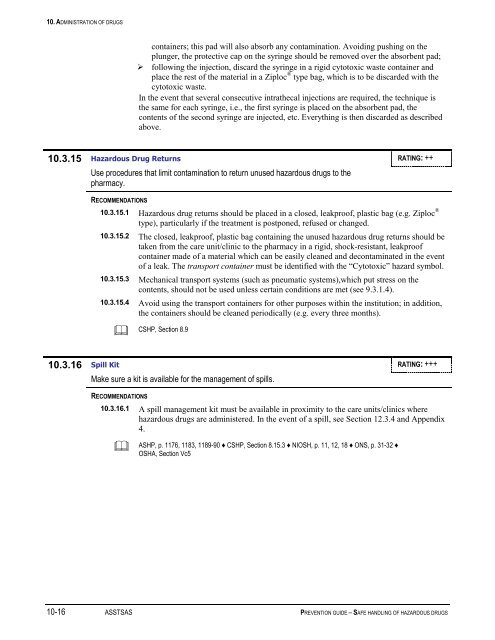Prevention Guide - Safe Handling of Hazardous Drugs - Irsst
Prevention Guide - Safe Handling of Hazardous Drugs - Irsst
Prevention Guide - Safe Handling of Hazardous Drugs - Irsst
You also want an ePaper? Increase the reach of your titles
YUMPU automatically turns print PDFs into web optimized ePapers that Google loves.
10. ADMINISTRATION OF DRUGS<br />
containers; this pad will also absorb any contamination. Avoiding pushing on the<br />
plunger, the protective cap on the syringe should be removed over the absorbent pad;<br />
‣ following the injection, discard the syringe in a rigid cytotoxic waste container and<br />
place the rest <strong>of</strong> the material in a Ziploc ® type bag, which is to be discarded with the<br />
cytotoxic waste.<br />
In the event that several consecutive intrathecal injections are required, the technique is<br />
the same for each syringe, i.e., the first syringe is placed on the absorbent pad, the<br />
contents <strong>of</strong> the second syringe are injected, etc. Everything is then discarded as described<br />
above.<br />
10.3.15 <strong>Hazardous</strong> Drug Returns RATING: ++<br />
Use procedures that limit contamination to return unused hazardous drugs to the<br />
pharmacy.<br />
RECOMMENDATIONS<br />
10.3.15.1 <strong>Hazardous</strong> drug returns should be placed in a closed, leakpro<strong>of</strong>, plastic bag (e.g. Ziploc ®<br />
type), particularly if the treatment is postponed, refused or changed.<br />
10.3.15.2 The closed, leakpro<strong>of</strong>, plastic bag containing the unused hazardous drug returns should be<br />
taken from the care unit/clinic to the pharmacy in a rigid, shock-resistant, leakpro<strong>of</strong><br />
container made <strong>of</strong> a material which can be easily cleaned and decontaminated in the event<br />
<strong>of</strong> a leak. The transport container must be identified with the “Cytotoxic” hazard symbol.<br />
10.3.15.3 Mechanical transport systems (such as pneumatic systems),which put stress on the<br />
contents, should not be used unless certain conditions are met (see 9.3.1.4).<br />
10.3.15.4 Avoid using the transport containers for other purposes within the institution; in addition,<br />
the containers should be cleaned periodically (e.g. every three months).<br />
<br />
CSHP, Section 8.9<br />
10.3.16 Spill Kit RATING: +++<br />
Make sure a kit is available for the management <strong>of</strong> spills.<br />
RECOMMENDATIONS<br />
10.3.16.1 A spill management kit must be available in proximity to the care units/clinics where<br />
hazardous drugs are administered. In the event <strong>of</strong> a spill, see Section 12.3.4 and Appendix<br />
4.<br />
<br />
ASHP, p. 1176, 1183, 1189-90 ♦ CSHP, Section 8.15.3 ♦ NIOSH, p. 11, 12, 18 ♦ ONS, p. 31-32 ♦<br />
OSHA, Section Vc5<br />
10-16 ASSTSAS PREVENTION GUIDE – SAFE HANDLING OF HAZARDOUS DRUGS

















